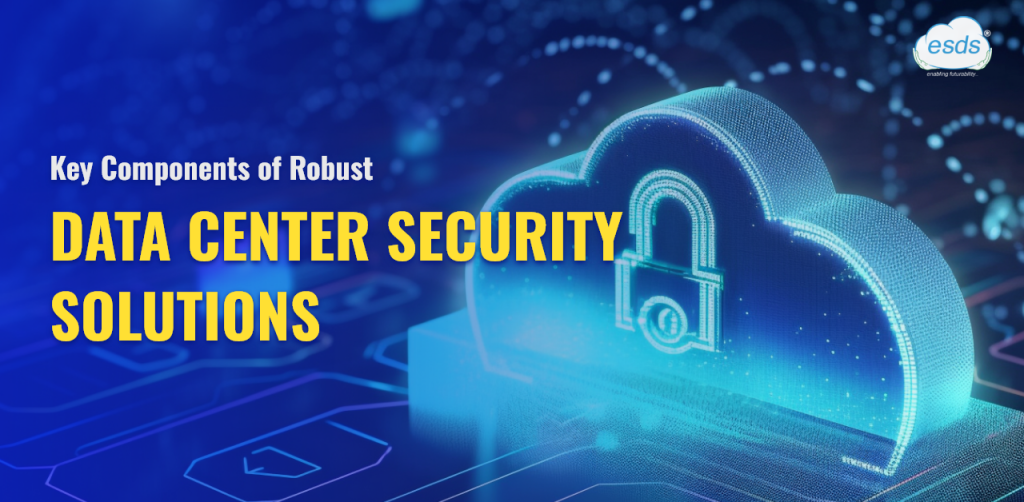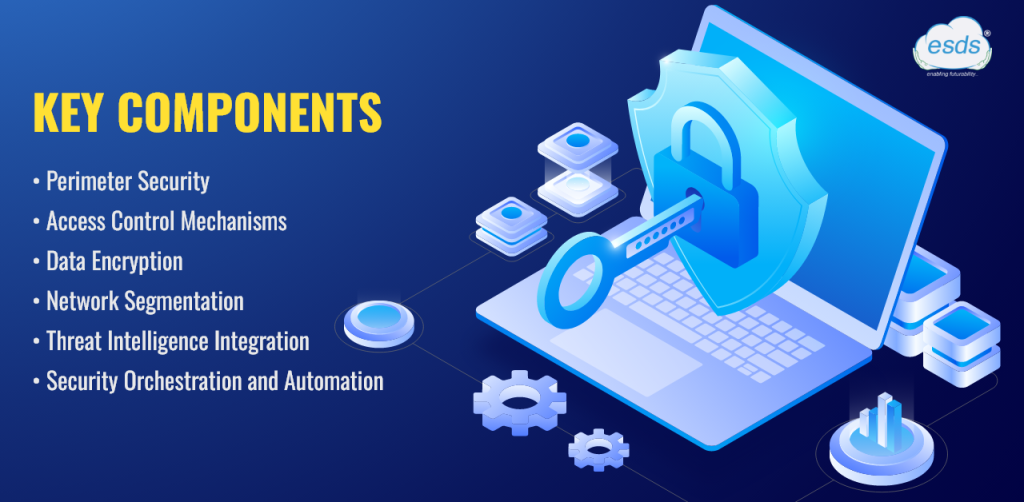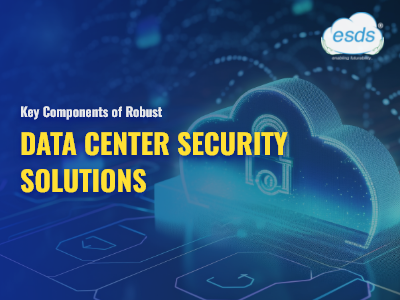Key Components of Robust Data Center Security Solutions

The backbone of enterprises is served by data centers where they house critical applications, sensitive information and valuable assets. In the face of increasingly sophisticated cyber threats, organizations must put in place strong Data Center Security Solutions. Intrusion detection systems, advanced firewalls as well as behavioural analytics algorithms and such like this are part of these solutions with a multifaceted approach that engages state-of-the-art technologies. Other important things include strict access controls, using encryption protocols, and regular security audits to help strengthen defenses against possible breaches. These key components need to be woven into the organization’s security posture so that it can truly provide risk mitigation and guaranteeing the integrity, availability and confidentiality of its data center environments. Further efforts should therefore be made for incident response mechanisms to be built alongside embedding a culture of cyber security awareness within staff members through extensive training programs.
Perimeter Security:
- Firewall Solutions: Data Center Security Solutions’ foundation element involves the use of Next Generation Firewalls (NGFW) to monitor and control incoming/outgoing traffic based on predefined security rules. Such modern firewalls go beyond just inspecting packets and additionally provide such functionalities as intrusion prevention, deep packet inspection, and application-level inspection. Network traffic can be precisely controlled, malicious threats can be identified and blocked and security policies enforced to protect valuable assets by making use of the NGFW technology.
- Intrusion Detection and Prevention Systems: In order to proactively detect and mitigate threats in a data center environment, it is important to deploy IDPS. These systems constantly monitor system and network activities, analyzing traffic patterns and behavior for signs of suspicious or unauthorized activities. By using signature-based detection, anomaly detection, and investigative analysis techniques; however, IDPS can identify different types of cyber threats like malware infection attempts; penetration attacks, or DoS attacks. In addition; after detecting a threat an IDPS solution may automatically block malicious traffic and isolate compromised systems; alerting security staff so that they can take necessary action and an investigation is carried out involving remediation efforts.
Access Control Mechanisms:
- Role-Based Access Control (RBAC): Establishing granular access controls based on user roles and privileges is essential for Data Center Security Solutions. RBAC ensures that only authorized personnel access specific resources and sensitive data, reducing the risk of unauthorized access and potential data breaches. By defining roles and assigning appropriate permissions, organizations can enforce the principle of least privilege, limiting users’ access to only the information and functionalities necessary for their job responsibilities.
- Multi-Factor Authentication (MFA): Using multi-factor authentication (MFA) to strengthen authentication techniques gives the login process an additional degree of protection, mitigating the risk of unauthorized access due to compromised passwords or credentials. Users using MFA must submit many types of verification, such as passwords and one-time passwords generated by mobile apps or hardware devices, before granting access to Data Center Security Solutions resources. By combining these factors, MFA significantly enhances the security posture of data center environments, reducing the likelihood of successful unauthorized access attempts, even in the event of stolen or weak passwords. Implementing MFA helps organizations bolster their defense against various cyber threats, including phishing attacks, credential theft, and brute-force attacks while ensuring secure authentication and access control.

Data Encryption:
- Data-at-Rest Encryption: Encrypting data stored in databases, servers, and storage devices is crucial for safeguarding sensitive information against unauthorized access in the event of a breach or physical theft. By employing robust encryption algorithms and cryptographic techniques, organizations can transform plaintext data into ciphertext, rendering it unintelligible to unauthorized individuals or malicious actors. Data Center Security Solutions with data-at-rest encryption ensure that even if adversaries gain access to the physical storage media or compromise the underlying systems unable to decipher the encrypted data without the appropriate decryption keys. This security measure helps mitigate the risks associated with data breaches, compliance violations, and insider threats, enhancing the overall resilience of data center environments.
- Data-in-Transit Encryption: Securing data transmission between servers, applications, and users is essential for protecting information as it traverses network infrastructure and internet connections. Data Center Security Solutions with data-in-transit encryption utilize encryption protocols such as Transport Layer Security (TLS) and Secure Socket Layer (SSL) to establish secure communication channels and encrypt data packets during transit. By encrypting sensitive data while it moves between endpoints, organizations can prevent eavesdropping, interception, and tampering by malicious entities or unauthorized parties. This encryption mechanism ensures data confidentiality, integrity, and authenticity throughout the transmission process, reducing the risk of data interception, man-in-the-middle attacks, and data breaches. Data-in-transit encryption strengthens the overall security posture of data center environments, particularly in cloud-based deployments and hybrid IT architectures where data traverses public networks and third-party infrastructures.
Network Segmentation:
- Virtual LANs (VLANs): Segmenting the network into isolated zones is a fundamental practice in Data Center Security Solutions to contain breaches and limit the lateral movement of attackers within the infrastructure. VLANs create logical network segments that operate as separate broadcast domains, allowing organizations to group resources based on function, department, or security requirements. By isolating traffic within VLANs, organizations can enforce access controls, restrict communication between different segments, and mitigate the impact of security incidents or compromises. VLANs enhance network security by minimizing the attack surface and preventing unauthorized access to sensitive systems or data, thereby bolstering the overall resilience of data center environments.
- Micro-Segmentation: Implementing fine-grained segmentation at the application and workload level is essential for enforcing security policies based on application dependencies and trust levels within data center environments. Micro-segmentation divides the network into smaller, isolated security zones at a granular level, allowing organizations to apply specific security controls and policies tailored to individual workloads, applications, or data flows. By segmenting traffic based on factors such as workload characteristics, user roles, or data sensitivity, organizations can avoid the risk of lateral movement by attackers and limit the potential impact of security breaches or compromises. Micro-segmentation enhances security posture by enforcing least privilege principles, isolating critical assets, and preventing unauthorized access or lateral traversal within the data center infrastructure. This approach strengthens defense-in-depth strategies and complements other security measures, such as VLANs and access controls, and cyberthreats, therefore lowering the possibility of data breaches and their possible effects on company operations.
Threat Intelligence Integration:
- Threat Feeds and Indicators of Compromise (IoCs): Integrating threat intelligence feeds into Data Center Security Solutions infrastructure is critical for proactively identifying and blocking known malicious entities, including suspicious IP addresses, domains, and file hashes. By leveraging threat feeds and indicators of compromise (IoCs), organizations can enhance their threat detection capabilities and preemptively thwart cyber attacks before infiltrating their networks or systems. Automated processes can continuously ingest and analyze IoCs from various sources, such as commercial threat intelligence providers, open-source databases, and security communities, to identify malicious behavior patterns and correlate them with ongoing activities within the data center environment. This proactive approach enables security teams to stay ahead of emerging threats, update security controls in real time, and fortify defenses against evolving cyber threats, therefore lowering the possibility of data breaches and their possible effects on company operations.
- Security Information and Event Management (SIEM): Centralizing log data and security events through Security Information and Event Management (SIEM) platforms is essential for comprehensive threat detection, incident response, and regulatory compliance within data center environments. Data Center Security Solutions that leverage SIEM solutions aggregate normalize and analyze data from disparate sources, including network devices, servers, applications, and security appliances, to provide holistic visibility into the organization’s security posture. By correlating log data and security events in real time, SIEM platforms can detect abnormal activities, identify potential security incidents, and facilitate rapid incident response through automated alerting and remediation workflows. Moreover, SIEM tools enable security teams to conduct forensic investigations, track user activity, and generate compliance reports to show that industry rules and internal security guidelines are being followed. By leveraging SIEM capabilities, organizations can improve threat detection and response capabilities, streamline security operations, and eliminate the risk of data breaches and compliance violations within their data center infrastructures.
Security Orchestration and Automation:
- Incident Response Automation: Leveraging automated workflows and playbooks is crucial for streamlining incident detection, analysis, and remediation processes within data center security operations. By integrating automation tools and orchestration platforms into Data Center Security Solutions, organizations can accelerate response times, minimize manual intervention, and reduce the risk of human error during security incident management. Automated workflows enable rapid triage and prioritization of security alerts, orchestrate response actions across diverse security tools and systems, and facilitate coordinated incident response efforts. Furthermore, predefined playbooks codify best practices and response procedures, ensuring consistency and efficiency in handling security incidents. By mechanizing repetitive processes, like gathering data, threat analysis, and containment, incident response automation enhances the effectiveness of security teams, enabling them to mitigate threats more effectively and minimize the impact of security breaches on data center operations and assets.
- Security Policy Automation: Automating the enforcement of security policies and configurations across heterogeneous data center environments is essential for maintaining consistency, scalability, and compliance with regulatory requirements. Data Center Security Solutions with security policy automation enable organizations to define, deploy, and enforce security controls consistently across physical, virtual, and cloud-based infrastructure components. By centralizing policy management and configuration orchestration, organizations can ensure that security policies are applied uniformly across all assets and environments, reducing the risk of misconfigurations and security gaps. Automated policy enforcement mechanisms monitor deviations from desired security posture, remediate non-compliant configurations, and provide continuous visibility and control over security policies. Moreover, security policy automation streamlines audit and compliance processes by generating reports, documenting policy changes, and demonstrating adherence to regulatory standards
Conclusion:
By integrating these key components into their data center security strategy, organizations can establish a robust defense posture capable of mitigating a wide range of cyber threats and ensuring their critical assets’ confidentiality, integrity, and availability. Investing in comprehensive data center security solutions is essential for maintaining trust, compliance, and business continuity in today’s digital age.
ESDS Software Solutions offers cutting-edge data center security solutions designed to safeguard your organization’s most valuable assets. With a focus on proactive threat detection, real-time monitoring, and adaptive response mechanisms, our solutions provide unparalleled protection against evolving cyber threats. From advanced firewalls and intrusion detection systems to encryption technologies and security analytics, ESDS empowers organizations to fortify their defenses, safeguard sensitive data, and uphold the highest standards of security and compliance. Trust ESDS to elevate your data center security posture and protect your business from emerging cyber risks.
- How SOAR Improves Threat Detection and Response Times - June 18, 2024
- Battle Plan for Top 10 Database Administration Headaches. - June 13, 2024
- Key Components of Robust Data Center Security Solutions - May 17, 2024

